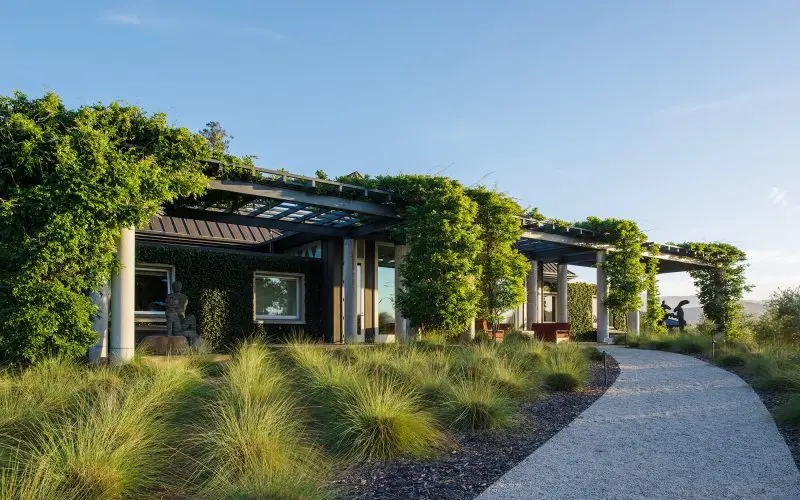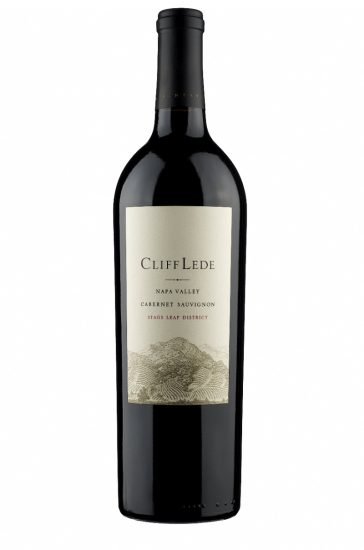Whit Cook is the Founder/Publisher of GoodLife Report (GLR), a…
Cliff Lede makes Cabernets and Bordeaux-style blends that typify the Stag’s Leap District of Napa Valley
Bordeaux style blends from Napa Valley have always been a favorite of mine. Whether it’s a left bank style (heavier on the Cabernet Sauvignon), a right bank style (heavier on the Merlot and Cab Franc) or somewhere in the middle, the concept of blending varietals together to make a more rounded, complex wine has been around for a long time. The French championed the style a couple centuries ago in Bordeaux—more out of necessity than preference, since their climate does not always yield ripe enough fruit. Thus blending was needed to smooth out the edges and soften the tannins. Napa’s trailblazer vintners were initially reticent to blend because they did not want to copy the French—nor did they need to. Thanks to its warm climate and consistently sunny days during most of the growing season, a lack of ripeness is rarely a problem in Napa. But the practice eventually took hold nonetheless. Joseph Phelps is considered by many to be the first winery in Napa Valley to practice the technique, back in the 1970’s. Their flagship wine “Insignia,” considered the first Bordeaux-style blend in Napa, remains one of my favorite wines to this day.
Of course, many producers in Napa Valley still prefer to make 100% Cabernet Sauvignon and excel at it. Caymus Special Selection and Shafer Hillside Select are two of the most revered Napa cabs on the market, with international name recognition and cult-like status—not to mention hefty price-tags. Thanks in part to ideal vineyards plots, perfect soil and a long growing season—these producers can make world-class red wines that consist of 100% Cabernet, yet with decidedly soft, plush tannins and layers of complexity that might easily be mistaken for a blend. While most Napa wineries tend to concentrate—and subsequently excel—at one or the other, a few excel at both.
Cliff Lede, located in the Stag’s Leap district of Napa Valley, is one of these producers that has mastered both. They make blends—namely their “Claret” and “High Fidelity” labels. And they make Cabernet—though depending on the label and the vintage it could be anywhere from 85% to 100% Cabernet, give or take a few percentage points. All of their wines, even their Sauvignon Blanc, are extraordinary in my opinion. Before I delve more into their wines, let’s take a quick look at the winery itself and it’s rather short, yet successful history in Napa Valley.
History of Cliff Lede

Cliff Lede Vineyards was established in 2002 by Canadian born Bordeaux enthusiast, Cliff Lede, following the acquisition of a sixty acre estate in the Stags Leap District of Napa Valley. With a focus on producing wines from estate vineyards, Lede tapped David Abreu, considered the best viticulturist in Napa Valley, to replant the vineyards. Lede decided to name each vineyard block after some of his favorite rock songs and albums—from “My Generation” to “Dark Side of the Moon,” creating what is known today as the Cliff Lede Vineyards “Rock Blocks.” In 2005, a state of the art, 25,000 square foot winery and cave system was etched into a hillside overlooking the estate vineyards. Winemaker Christopher Tynan crafts Cabernet Sauvignon and Sauvignon Blanc, with the flagship, Poetry Cabernet Sauvignon, sourced from the steep eastern hillside portion of the estate.
Ok, so what makes these wines special? After all, Napa Valley is home to a lot of great producers. For me, it’s the balance, complexity and polish of their wines. And while winemaker Christopher Tynan deserves a lot of credit, even he would probably agree that the vineyard plots Cliff Lede lays claim to in the Stag’s Leap District play a major role in the final product. There are 16 AVAs in total in Napa Valley and each one has different characteristics. Yet, while the differentiating characteristics of these AVAs can be debated, it is hard to argue against the notion that Stag’s Leap District Cabernets have distinctively softer, silkier tannins than their neighboring AVAs. This is what SLD Cabernets are known for. Power and elegance.
Situated in southeastern Napa Valley, along the Silverado Trail, about five miles north of the city of Napa, the Stags Leap District is only about a mile wide and three miles in length. This makes it is one of the smallest AVAs in Napa Valley. And given its southern location in Napa Valley, it is also one of the cooler AVAs, resulting in a more subdued style of Cabernet Sauvignon.
Often referred to as a “valley within a valley,” the district is bounded on the east by the towering Stags Leap Palisades, to the west by the rolling hills and Napa River, to the north by the Yountville Cross Road, and to the south by low-lying flatlands. These landscape features lend the district its clear physical identity while a unique set of topographical characteristics make it ideal climate for growing Cabernet.
Says the Stag’s Leap District Winegrowers Association, “The rock facades of the palisades reflect the heat of the sun onto the vineyards below, causing temperatures to rise more quickly than in neighboring vineyards. As afternoon draws to a close, the hills funnel the cool, marine air flowing north from the San Pablo Bay through the Stags Leap District corridor. The cooling effect of this breeze, coupled with nighttime air drainage off the mountains and hills, means lower nighttime temperatures. This allows the grapes to achieve an excellent balance of acid and sugar and also minimizes the threat of frost. The end result is a longer growing season of warm days and cool nights—perfect for late-maturing varietals such as Cabernet.”
Cliff Lede currently produces a total of 10 Cabernet and Bordeaux-style blends. While all of them are muscular enough to stand up to a steak or lamb chops in the heart of winter they are also very elegant wines that can be enjoyed anytime of year with a wide array of cuisines. Below are my notes for the three wines I tried.
2017 Cliff Lede Cabernet Sauvignon, Stag’s Leap District

The fruit for this Cabernet (88% Cabernet Sauvignon,5% Merlot, 4% Petit Verdot, 3% Cabernet Franc) was sourced from the hillside terraces of Cliff Lede’s Poetry Vineyard, Twin Peaks Vineyard estate which surrounds the winery, and a few neighboring vineyards in the Stags Leap District. The wine is composed of small lots from their best blocks, representing a diverse range of carefully selected clones and rootstocks. This wine is also rich in soil diversity ranging from Poetry’s volcanic origins, to the ancient riverbed alluvial soils of Twin Peaks, further contributing to the wine’s complexity. Great wines are indeed “made in the vineyard.”
The 2017 Stags Leap Cabernet has vibrant aromas of crushed flowers and dark fruits (blackberry, dark cherries) intertwined with chocolate, spice box and cassis. The wine has tremendous depth and layers of flavors that build into a long opulent finish that is framed with great minerality and loamy soil that personifies the SLD terrior.
2017 Dancing Heart Cabernet Sauvignon, Stag’s Leap District (Rockpile Vineyard)

89% Cabernet Sauvignon, 7% Petit Verdot, 3% Merlot, and 1% Malbec. The fruit for this one is sourced from Lede’s Poetry and Twin Peaks Vineyards. The Cabernet Sauvignon is planted in shallow volcanic soil and farmed to low yields, resulting in good structure with plush tannins and tremendous concentration.
This wine announces itself a bit more on the nose than the Stag’s Leap Cabernet, wafting with a bouquet of dark berry fruits, lavender and cocoa. Wonderfully complex with minerals and slate/graphite on the finish.
2017 Poetry Cabernet Sauvignon, Stag’s Leap District

The Poetry Vineyard, carved into a steep west-facing hillside, reaches from the highest elevations of the Stags Leap District appellation to the valley floor. This vineyard, designed by David Abreu specifically for Cabernet, draws its uniqueness from shallow, volcanic soils atop fractured shale. Due to the stressful nature of the site, planted with high vine density and farmed to very low yields, the vines develop slowly and produce small flavorful berries.
A blend of 88% Cabernet Sauvignon, 7% Cabernet Franc, 1% Merlot, and 4% Petit Verdot the bouquet on this one is loaded with black currants, crushed flowers, stone and cherry liquor. On the palate it has a complex medley of spices, tobacco, licorice, currant, dark cherries and even hoisin. The long finish includes cigar, dried cherries and warm slate.
Whit Cook is the Founder/Publisher of GoodLife Report (GLR), a lifestyle website geared towards men and women who like unique products and experiences. GLR editors have written for prominent publications and web sites including Wine Spectator, Cigar Aficionado, Travel+Leisure, Conde Nast Traveler, Huffington Post, Men’s Journal and Pursuitist.

